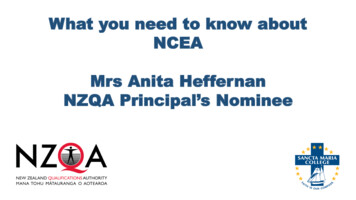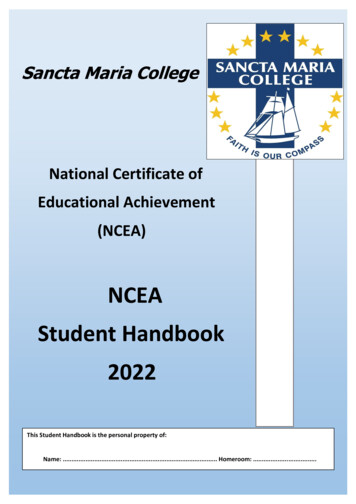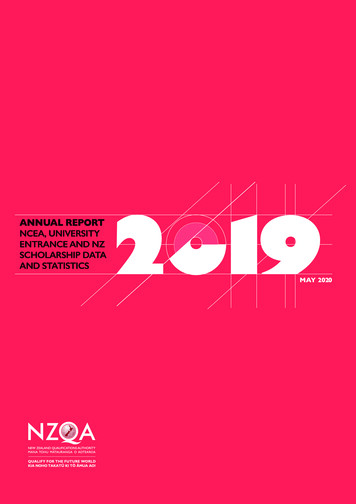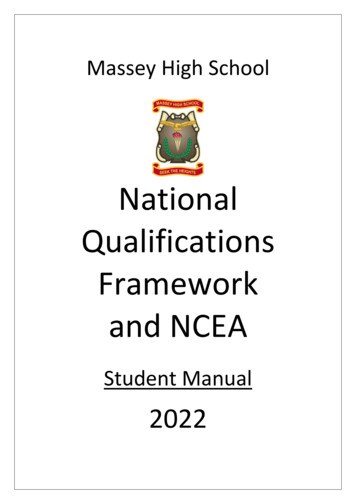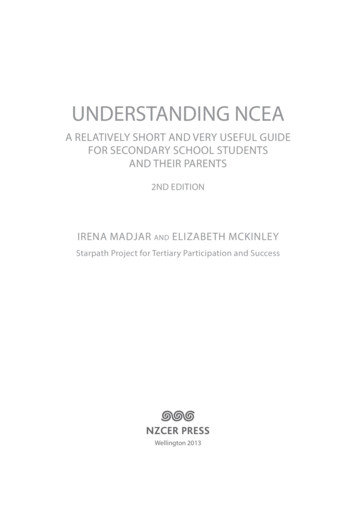
Transcription
UNDERSTANDING NCEAA RELATIVELY SHORT AND VERY USEFUL GUIDEFOR SECONDARY SCHOOL STUDENTSAND THEIR PARENTS2ND EDITIONIRENA MADJAR and ELIZABETH MCKINLEYStarpath Project for Tertiary Participation and SuccessWellington 2013
New Zealand Council for Educational ResearchPO Box 3237WellingtonNew Zealand Irena Madjar and Elizabeth McKinley, 2013ISBN 978-1-927231-00-5All rights reservedNational Library of New Zealand Cataloguing-in-Publication DataMadjar, Irena.Understanding NCEA : a relatively short and very useful guide forsecondary school students and their parents / Irena Madjar andElizabeth McKinley (Starpath Project for Tertiary Participation andSuccess). 2nd edition.ISBN 978-1-927231-00-51. National Certificate of Educational Achievement (New Zealand)2. Education, Secondary—Curricula—New Zealand. 3. Vocationalguidance—New Zealand. I. McKinley, Elizabeth Ann. II. Title.373.12620993—dc 23Designed by Cluster CreativeIllustrations by James WatsonPrinted by Printlink, WellingtonThis title is also available as an e-book from www.nzcer.org.nz/nzcerpress.Distributed by NZCERPO Box 3237WellingtonNew Zealandwww.nzcer.org.nz
u need a book to understand NCEA?!12How this book can help you141 Getting to grips with NCEA15The essential things you need to know about NCEA16A few other things you need to know about NCEA23What you need to know about the University Entrance award26What you need to know about the New Zealand Scholarshipaward28Key points312 If science is your thing35Introduction36Rangi36Leilani40Jason45Key points503 If you prefer arts and social sciences53Introduction54Jessica54Benji58Lucy63Key points69
4 If business and commerce is where you want to be73Introduction74Jack75Anna81Michael86Key points925 Builder, plumber, soldier, chef?Introduction9596Apprenticeships97Armed services102Key points1116 What parents can do to help113Introduction114Getting started with NCEA115Making NCEA work for your child122Key points130Appendix 1133Curriculum flow chartsAppendix 2139Significant standards for progression to higher levels withincore subjects of English, mathematics and scienceAppendix 3143Useful websites and sources of further informationGlossary149
ACKNOWLEDGEMENTSThe Starpath Project for Tertiary Participation and Success wasestablished in 2005. Its aim is to investigate ways of transformingcurrent patterns of educational underachievement in New Zealandsecondary schools, particularly for Māori and Pacific students, andstudents from low- to mid-decile schools. One of the barriers tostudent success we identified was that many parents, students andeven teachers have a poor understanding of NCEA (the NationalCertificates of Educational Achievement).This book was born out of our realisation that, when it comes toNCEA, parents, students and schools are often talking past each other.Our research indicates that parents are still struggling to understandhow NCEA can work for their child. Students are often left to managetheir own NCEA pathways. Some do it very well indeed, but too manystudents work out where the short cuts might be (such as how to getthe most credits for the least effort), without appreciating the longerterm consequences of their decisions.Hence this book! In it we have drawn on our research and writtenspecifically for students and parents—not for academics or researchers(unless they are also parents still trying to work out the ins and outsof NCEA). All the stories in the book are based on our research, butin each case we have combined a number of stories, changed namesand other identifying details, and added a few elements to make thematerial easier to understand.This book would not have been possible without the heartfelt storiestold to us by many students and parents who took part in our research.GETTING TO GRIPS WITH NCEA // 5
We thank them for giving us the material from which to write, and thereason for writing. If other students and their parents, new to NCEA,find this book useful we will have achieved our goal.This second edition of the book was made necessary by a numberof changes to the NCEA regulations over the past 2 years, includingthose related to numeracy and literacy and the University Entrancerequirements.We are grateful to the Starpath partner schools who continue to teachus about the realities and challenges of educating our young people.Thank you to the Starpath research team, and in particular SeiniJensen, who undertook many of the parent and student interviewsand ensured we heard the stories we needed to hear.We also acknowledge all those who have provided suggestions andfeedback on the initial drafts of this book—in particular, Dr SamanthaSmith for her intellectual input and clarifying comments; Mr MichaelWithiel for his thorough and insightful critique; Shona Ramsay, SeniorPolicy Analysis at NZQA; and the many anonymous students andparents for their comments and suggestions.The curriculum flow charts in Appendix 1 are reproduced with thepermission of Kaitaia College, and we thank the school for allowing usto use this material.Finally, we thank David Ellis, publishing manager at NZCER Press, forchampioning the book and helping us, expertly and patiently, throughthe sometimes intricate publication process, and James Watson for hisquirky but brilliant illustrations.Irena Madjar and Elizabeth McKinleyStarpath Project (www.starpath.auckland.ac.nz)The University of AucklandJuly 20136 // UNDERSTANDING NCEA
FOREWORDNCEA can seem like a mystery for those who are new to it. Manyparents experienced a system where they were asked to study all yearand then sit exams at the end (usually in the gym or the hall). Theywould then wait for their results to come in the mail, during January,to reveal whether they had succeeded or not. A whole year’s workdepended on a few exams!This is not how NCEA works. Since NCEA was introduced in 2002 ithas been reviewed and improved and has become New Zealand’s mainqualification system for secondary school students. But it is not asstraightforward as the exam-based qualifications.There were good reasons for introducing NCEA. The nature and rangeof jobs have changed since parents were at school, tertiary educationno longer depends solely on end-of-year exams, and there are manymore tertiary courses to choose from. This means that today’s studentsneed to be prepared differently.Think of the modern workplace: the job performance review is basedon many things that occurred during the past year and not on onesingle task. During the year an employee will be asked to completemany tasks, learn new things and put these into practice. This isthe same with NCEA: there are many ways to learn new things (viacredits and courses), many ways to put these into practice (internaland external assessments), and multiple ways for performance to bevalued (Excellent, Merit, Achieved). As in the average workplace (andFOREWORD // 7
certainly when learning challenging material), there may also be morethan one opportunity to succeed in a task.However, this flexibility of NCEA comes with complexity, which can leadto many questions. This book aims to provide many of the answers andto help you identify which questions to ask. It is based on a numberof years of research in schools—interviewing students, teachers andparents, analysing patterns and results, and publishing many articles.The complexity of NCEA means there can be “chokepoints”: pointswhere poor decisions are made that can have negative consequenceson students’ aspirations. It could be that the school does not offer theoptimal balance of courses for the student to choose from. Studentscould be aiming too low and choosing the easier subjects, which maylater prevent access to desired courses. Or students and families maynot be planning a sequence through NCEA. This book will be invaluablefor addressing these and many other chokepoints, and the questionsthat arise from them.The Starpath team is the foremost research group on NCEA, analysingthe effects in schools and the effects of NCEA on students when theymove beyond the school gates into tertiary study, the workplaceand other destinations. One of the more exciting findings is thatperformance in NCEA is among the world’s best predictors of successin later studies. This is because NCEA requires that students learnto study throughout the year, complete assignments to specifiedstandards, and learn continually from these assignments how toimprove their work. Their performance is assessed across manypieces of work and not just one test on one day of the year. This is howuniversity and most workplaces now operate.I encourage parents and students to use this book as a source ofinformation and a point of discussion, to work through the examplesseeing how the courses are put together and, most importantly, knowwhat questions to ask your school. Don’t leave the school out of the8 // UNDERSTANDING NCEA
questioning—they are keen to help answer your queries—and afterreading this book you are more likely to have the right questions toask them.Professor John HattieFormerly of the Faculty of EducationThe University of AucklandFOREWORD // 9
INTRODUCTIONOnce upon a time students turned up at school and teachers decidedwhat they needed to learn, how they should be taught, and what gradesor qualifications they had earned. Today things are very different,especially when it comes to senior high school years and the NationalCertificates of Educational Achievement (NCEA). NCEA is the nationalschool leaving qualification, used by the majority of secondary schoolsin New Zealand. It allows students to choose from a large number ofsubjects, to decide how much content they wish to learn and, to acertain extent, to decide how they wish to be assessed.Under the pre-2002 system, students who failed to achieve SchoolCertificate or a higher qualification came away with a failed record.Achievement depended entirely on the end-of-year exam results foreach subject, and national results were adjusted so that only half ofthe students passed.The NCEA system, introduced in 2002 and used during the final 3 yearsof secondary schooling, is different in several ways. Students’ learning is assessed both during and at the end of theschool year. Assessment is “standards based”. In other words, if a studentachieves a set standard for a particular section of a subject or course,he or she is awarded a pass, regardless of how any other studentsperformed.GETTING TO GRIPS WITH NCEA // 11
Students’ Records of Achievement document what the studentshave learned and what skills they have mastered, for all the coursesthey have undertaken.NCEA is offered at three levels: Level 1 (usually in Year 11), Level2 (usually in Year 12) and Level 3 (usually in Year 13). A particularcombination of subjects, mostly at Level 3, makes up the UniversityEntrance (UE) qualification.On the surface, then, NCEA can seem simple and straight forward. So,why do we think that students and their families might find this bookuseful when dealing with NCEA for the first time, such as at the endof Year 10, when students are choosing subjects for NCEA Level 1 inYear 11? And why might it also be helpful to students further along theNCEA path?YOU NEED A BOOK TO UNDERSTANDNCEA?!The main reason we wrote this book was because NCEA is bothcomplex and flexible, and that can make it difficult to understand forpeople who are new to it. Our aim is to make NCEA understandable,so that students and their families can make NCEA work for them andhelp them reach their goals. This is especially important for studentsaiming to go on to tertiary education, including university.NCEA is complexNCEA is complex because it is designed to meet the needs of studentswith a broad range of abilities and interests. It can accommodatestudents who need to prepare for university studies in medicine orengineering, those who plan to undertake apprenticeships in buildingor hairdressing, as well as those who want to learn mostly practicalskills and join the workforce directly from school. This means that alarge high school might offer 40 or more subjects, from accounting to12 // UNDERSTANDING NCEA
woodwork. Because each student is able to take only five or six subjectseach year, how do you decide which subjects to take?To make things more difficult, many subjects have prerequisites. Thismeans that to be allowed to do music, or French, at Level 3 (Year 13),for example, a student needs to have done these subjects at Levels 1(Year 11) and 2 (Year 12). Sometimes schools will allow a student to goon without a specified prerequisite, but in most cases the expectationis that the prerequisites listed in the school curriculum guide will bemet. How does a student at the end of Year 10 know what he or she willwant to study 3 years later?NCEA is flexibleBecause it is designed to meet the needs of students with differentinterests and abilities, NCEA is flexible. This means that: schools can select which standards (components) to include in asubject and can adjust subject content to suit the learning needs oftheir students students can study catering along with physics, and many othercombinations of subjects students can study at different Levels of NCEA at the same time,even within the same subjects or courses students can complete non-NCEA subjects and have them creditedtowards NCEA, and they can use NCEA credits towards other (nonNCEA) qualifications.This flexibility also means that schools can offer different versions ofcore subjects such as English, maths and science—some designed for“academically able” students going on to university, and others forstudents thought to need a more “practical” or “applied” knowledge ofthese subjects.INTRODUCTION // 13
HOW THIS BOOK CAN HELP YOUNCEA’s complexity and flexibility can be a trap for students withoutclear goals, good advice, and careful planning. We hope this book willhelp you become more informed about how NCEA works, and howyou can make it work for you. The first chapter outlines how NCEAworks. It is intended primarily for students, but it is important thatparents read it too.The final chapter is written specially for parents/whānau and explainswhy it is important that, as parents, you talk with your children (andtheir teachers) about their subject choices, how well they are doing atschool, and what they hope to do when they leave school. To help yourchildren you need to understand what they are doing, when you canstand back, and when it might be a good idea to step in and talk withthem or their school.Chapters 2, 3, 4 and 5 are based on stories of students making differentkinds of subject choices, some helpful, some not. Based on real-lifeexperiences of over 120 students we have talked with in the course ofour research, these stories show how students can plan their pathwaysthrough the three NCEA years and what can happen when they makegood (or not so good) choices. Individual names are made up, and thestories are based on a whole collection of different stories and do notdescribe specific individuals.A list of useful websites for further information is provided at the endof the book.14 // UNDERSTANDING NCEA
1GETTING TO GRIPSWITH NCEAGETTING TO GRIPS WITH NCEA // 15
NCEA is a national school leaver qualification that fits within the largerNew Zealand Qualifications Framework. Most of the subjects offeredby secondary schools in New Zealand are based on the Learning Areasin the New Zealand Curriculum (which provides a framework for whatsecondary schools are expected to teach). Some schools also offer unitstandards in other subjects, such as business administration or animalcare, that are not part of the New Zealand Curriculum but can earncredits towards both NCEA and other (non-NCEA) qualifications.Before choosing any subject, you need to know how it willhelp you achieve at school and how well it will prepare you forfurther education or work after school.THE ESSENTIAL THINGS YOU NEED TOKNOW ABOUT NCEAStandards and creditsSecondary schools offer subjects made up of standards (subjectcomponents) that are assessed to meet the NCEA requirements.Each standard carries a certain number of points or credits (typicallybetween 2 and 6) that are awarded when you satisfy the assessmentfor that standard.A subject such as Level 1 English might be made up of anywhere from4 or 5 to 10 or more standards, which can allow you to earn as manyas 24 or more credits. For example, a standard might require that youproduce examples of formal writing such as a job application, andcarry 3 credits; another standard might require that you create anddeliver a speech, and carry a further 3 credits.If you do not submit required work or sit the required test or exam for aparticular standard, you will not earn any credits for that standard, butyou can still earn credits for other standards in the same subject.16 // UNDERSTANDING NCEA
Don’t be tempted to skip standards that carry only 2 or 3 credits; thecontent could be very important.Schools usually offer two types of standards: achievement standards,which come from the New Zealand Curriculum (in subjects such ashistory, chemistry, maths, or English), and unit standards, whichusually come from other qualifications such as hospitality, technology,or business administration.Assessment and grades In place of traditional A, B, C, D grades, NCEA credits are awardedas Not Achieved (N), Achieved (A), Merit (M) or Excellence (E).Achievement standards are assessed using all four grades. In mostcases unit standards are assessed using only the Achieved and NotAchieved grades. Some assessments (including all unit standard assessments) aredone internally, during the school year, by the teachers teachingthe subjects. Other assessments are done externally (through examsor portfolios), at the end of the school year, by specially appointedexaminers. Subjects are often made up of a combination of internallyand externally assessed standards, allowing students to earn somecredits during the year and additional credits through end-of-yearexternal assessments. If a student fails to achieve a standard or a set of standards thatare internally assessed, there is usually one further opportunity toresubmit written work or be reassessed for it. For externally assessedstandards there is only one opportunity to achieve the standard—atthe end of the school year. (A second attempt would have to waituntil the end of the following year.)GETTING TO GRIPS WITH NCEA // 17
Ensuring the system works fairlyNCEA is managed by the New Zealand Qualifications Authority(NZQA), which also approves and monitors other qualifications on theNew Zealand Qualifications Framework. NZQA ensures that schoolsmaintain similar standards of internal assessment, by a process calledmoderation. This involves a sample of students’ work already assessedby a teacher being sent for assessment by an external teacher (amoderator) so that standards of assessment across different schoolscan be compared. Feedback is provided so that, if necessary, teacherscan adjust their marking criteria for future use to indicate results thatare similar to those provided by teachers from most other schools.Achieving NCEA Level 1Most students start to study for NCEA in Year 11 (5th form in theold system), although it is possible to start in Year 10 or even earlier,especially in areas such as music performance, te reo Māori or otherlanguages in which a student is achieving well already.“IT IS UP TO YOU TO DECIDE HOW HARD YOU WANTTO WORK AND WHICH ASSESSMENTS YOU WANTTO ATTEMPT.In Year 11 you will be required to take five or six subjects. This dependson the school and the school timetable. English (or te reo Māori) andmaths (or pāngarau) are compulsory in almost all schools at this level.Some schools add a third compulsory subject. Usually it is science, butit might be physical education or another subject.You are free to choose the remaining subjects, but your choice mightbe restricted by which subjects are available in your school, how thetimetable is organised, and how well you have done on various tests18 // UNDERSTANDING NCEA
and assessments the previous year. Potentially, you will be given theopportunity to earn 120 or more credits across five or six subjects. It isup to you to decide how hard you want to work and which assessmentsyou want to attempt.To gain NCEA Level 1 you will need to earn: a total of at least 80 credits, including at least 10 credits showing literacy skills at least 10 credits showing numeracy skillsLiteracy credits are intended to demonstrate your reading, writing,speaking and listening skills. They can be earned through either: Specified Achievement Standards available through a range ofsubjects (such as English, te reo Māori, history, or social studies),OR Specified Unit Standards. These come as a package of threestandards, together worth 10 credits, and all three must becompleted successfully to meet the literacy requirement.Note that you have to meet the literacy requirements through eitherspecified Achievement Standards or the specified Unit Standards, butnot a mix of the two.There is one further way to meet the literacy requirements and that isthrough a special Level 4 subject called English for Academic Purposes.This subject is made up of two Unit Standards each worth five credits.Students taking this option may choose to achieve both readingand writing credits through this subject, or to achieve only readingor writing this way and to achieve the other part through specifiedAchievement Standards.Numeracy credits are intended to demonstrate your number,measurement, and statistical skills. They can be earned through either:GETTING TO GRIPS WITH NCEA // 19
Specified Achievement Standards available through a range ofsubjects (such as maths, pāngarau, geography, or science), OR Specified Unit Standards. These come as a package of threestandards, together worth 10 credits, and all three must becompleted successfully to meet the numeracy requirement.Note that you have to meet the numeracy requirements through eitherspecified Achievement Standards or the specified Unit Standards, butnot a mix of the two.Your school will help to ensure that you are enrolled in appropriatestandards to achieve the literacy and numeracy requirements. You canalso check the full list of these on the NZQA website qualifications/ncea).“EACH YEAR OF STUDY PROVIDES THE FOUNDATIONFOR THE NEXT YEAR’S WORKMost students should aim to complete NCEA Level 1 in Year 11, andto complete more than the minimum 80 credits, especially if they areaiming to go on to tertiary education. However, the flexibility of NCEAallows students to take Level 1 subjects in Years 12 and 13, and somestudents might need the extra time. You do not have to complete NCEALevel 1 to be allowed to take Level 2 subjects and complete NCEA Level2, but it is better if you do. Conversely, you could take some higher-levelstandards in Year 11, especially if you are doing well in particular subjectsand your teachers think you are ready for more advanced study.Overall, each year of study provides the foundation for the next year’swork, and it is much easier to do well if you have a solid foundation onwhich to build at each new level of learning. In Appendix 1, at the endof the book, we have included a flow chart that shows how subjects inearlier years connect to what students can do in later years. The flow20 // UNDERSTANDING NCEA
charts come from one school and are provided as an example only.Your school will have similar charts (usually included in a CurriculumGuide or NCEA Subject Handbook) that will list all the subjectsavailable at your school and show how specific subjects are connectedfrom Years 10 or 11 through to Year 13.Achieving NCEA Level 2In most schools in Year 12 you will be required to take English (or tereo Māori). Many schools require their students to also take maths(or pāngarau) at this level. The choice of the optional three or foursubjects is very important at this point. Level 1 maths and scienceserve as prerequisites for subjects such as statistics, physics, chemistryand biology. Good performance in Level 1 English can also act as aprerequisite for subjects such as drama, media studies or socialstudies. But prerequisites become stricter for Level 3, so you need tothink carefully about the subjects you might like to take in Year 12, andalso whether these subjects will allow you to study what you mightwant (or need) to study in Year 13. (See Appendix 2 for further detailsabout specific standards that are important for progression to higherlevel studies.)To gain NCEA Level 2 you will need to earn: at least 60 credits at Level 2 or above, and another 20 credits at anyother level (these 20 credits can come from already-earned Level 1credits). From 2013, you must also meet the Level 1 literacy and numeracyrequirements.Although it might seem that NCEA Level 2 is easier to achieve thanLevel 1 (because fewer credits are required), the material you will bestudying will be at a higher academic level, so you will need to step upto the challenge. Again, making the most of what you are able to learnat Level 2 will help you to be well prepared for the following year. NoteGETTING TO GRIPS WITH NCEA // 21
that you might be able to progress to NCEA Level 2 study, even if youdid not achieve NCEA Level 1 the previous year. But, if you did notachieve the literacy or numeracy requirements you will need to do sobefore you can be awarded NCEA Level 2.Remember that this is the minimum requirement. Most students can,and do, earn more than 60 Level 2 credits. This is important for tworeasons: You are required to take five or six subjects, each with 20 or morecredits, so you should be making the most of the opportunities tolearn as much as you can in each of these subjects. You need to make sure that you achieve enough credits in eachsubject to meet the “subject pass” or prerequisite rule at your school,so that you are able to study these subjects at a more advanced levelin Year 13. Schools usually require at least 12, and often as many as16 to 18 credits, for a subject pass at this level.If you are thinking about going to university when you leaveschool, instead of relying on the already-earned Level 1 credits,you should be aiming to achieve at least 80 or more Level 2credits.Achieving NCEA Level 3In Year 13 you will be free to choose all your subjects, but remember thatyour choices will be limited by the prerequisites you have completedin previous years. If you are aiming to go to university, check carefullywhich subjects are required for the programme you wish to study. Also,make sure that the subjects you take count not only towards NCEALevel 3 but also towards the UE award.To gain NCEA Level 3 you will need to earn: at least 60 credits at Level 3 or above, and another 20 credits atLevel 2 or higher (these 20 credits can come from already-earnedLevel 2 credits).22 // UNDERSTANDING NCEA
Any NCEA Level 3 subjects (and some non-NCEA Level 3 subjects1)can contribute credits toward the NCEA Level 3 qualification, but notall Level 3 subjects count towards UE.A FEW OTHER THINGS YOU NEED TO KNOWABOUT NCEANCEA is designed to meet the learning needs of all students in manydifferent subjects and with varying interests and levels of ability. Eachstudent’s Record of Achievement will document the knowledge andskills attained and the credits earned in the process. Every achievement(and every recorded credit) counts and will show on your Record ofAchievement.Why is achieving NCEA important?All students should be able to leave school with useful knowledgeand skills, preferably with a formal qualification. NCEA Level 1 is theminimum school leaving qualification, although current policy is thatthe majority of students should leave school with at least NCEA Level2. Achieving an NCEA qualification is important for many reasons.Here are some of the most important: Students who move from school to the workforce with an NCEAqualification have a higher chance of getting a job and being paid ahigher wage than those who leave without a qualification. How mucha person can earn is closely related to their level of education. Students who wish to take up an apprenticeship are usually requiredto have achieved certain levels of literacy and numeracy as well1 As already mentioned, school subjects with achievement standardsare part of the secondary schools curriculum. Other subjects can comefrom other certificate or diploma qualifications on the New ZealandQualifications Framework. Such subjects might include workshop skills,animal care or business administration, and there are many others.GETTING TO GRIPS WITH NCEA // 23
as other skills (see Chapter 5 for some examples). Those with anNCEA Level 2 qualification are much more likely to complete theirapprenticeships and become qualified builders, motor mechanics,plumbers, etc. than those without this qualification. Students who want to complete certificate or diploma courses(in technology, business, landscape gardening, aged care or otherfields) through industry training organisations, polytechnics orother training providers are generally expected to have completedNCEA Level 2, or a significant number of credits toward NCEA Level2, particularly in literacy and numeracy. Entry to degree-level studies at polytechnics usually requires UE orNCEA Level 3. Where the requirements for entry are less demanding(e.g., for diploma courses), strong performance at NCEA Level 2 isexpected. Entry to university degree-level programmes requires a minimum ofUE and a significant number of credits in subjects on the approvedlist (see Chapters 2, 3 and 4 for examples). In fact, some universitiesare now using a point system to rank students for selection intospecific de
Understanding NCEA : a relatively short and very useful guide for secondary school students and their parents / Irena Madjar and Elizabeth McKinley (Starpath Project for Tertiary Participation and Success). 2nd edition. ISBN 978-1-927231-00-5 1. National Certificate of Educational Achievement (New Zealand) 2.
